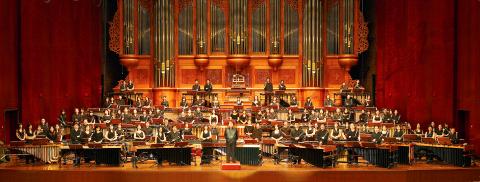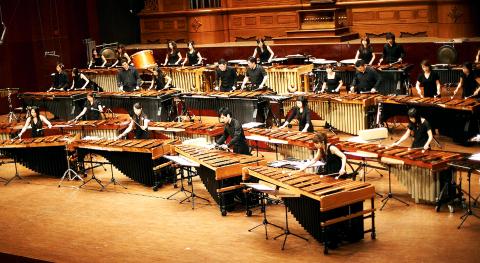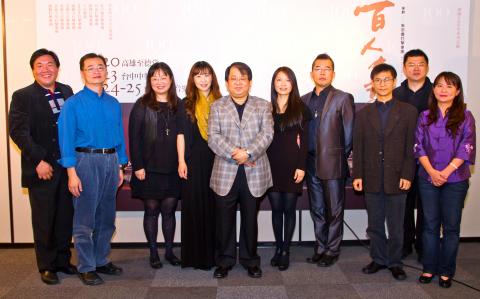With 64 marimbas resonating in unison, the Ju Percussion Group along with nine other renowned domestic percussion groups and 100 Taiwanese percussionists gave a remarkable concert in Kaohsiung last Sunday. However, if you missed the Kaohsiung concert, they will continue to touch audiences with their extraordinary sounds in Taichung tomorrow and Taipei on Thursday and Friday.
Ju Percussion Group artistic director and chief organizer of the event, Ju Tzong-ching, said, “A one hundred-member marimba concert is a rare event anywhere in the world, and it is generally not a long term thing. Making it possible requires bringing together many instruments and musicians at once.” Borrowing instruments, the shipping process, selecting a performance venue that can accommodate such a huge ensemble, and getting everyone together against all odds for a rehearsal, is a formidable challenge both on and off-stage.
In a telephone interview with the Taipei Times last Thursday, Ju Percussion Group senior percussionist Hwang Kuen-yean said a concert with a hundred people often gives the impression of a mish-mash thrown together sacrificing professional skills. But he said the 100 performers at this grand concert are not gathered just for the sake of reaching 100; rather, they are all well-trained Taiwanese percussionists upholding professional standards.

All photo courtesy of Ju Percussion Group Foundation
照片由財團法人擊樂文教基金會提供
Unlike a xylophone, a five-octave marimba produces a deep and rich tone quality and achieves a wide range of different tone colors. In the concerts, a tacit understanding between the 100 musicians is required for them to be able to stay in rhythm and render a professional and harmonious sound. Through the use of various types of mallets to strike different parts of the instruments and exquisite marimba playing techniques, the musicians turn the marimbas into a sizable symphonic ensemble with different instrumental parts. These concerts could be seen as a milestone in the attempts over the past 20-odd years to introduce the marimba to Taiwan.
Conducted by Ju and Forum Music Director Hsu Po-nien, the program includes works ranging from baroque to modern music and from eastern to western music. Works arranged for the 100 musicians include Johann Sebastian Bach’s Toccata and Fugue in d minor, BWV 565, Mussorgsky’s Pictures at an Exhibition, and renowned Taiwanese composer Hung Chien-hui’s Kao-a-hi Fantasy inspired by the popular Taiwanese gezai opera piece “White Horse.” Hwang says Bach’s piece given Bach’s status as the “father of music” and the grandeur of the piece makes it an appropriate opening piece. Mussorgsky’s piece is a suite in 10 movements; therefore, it gives the musicians a chance to show off the marimba’s different musical expressions. Hung’s Kao-a-hi Fantasy, originally composed for steel pan in 2009, is a double concerto transcribed for marimbas as melodic instrument and two sets of western and Chinese drums. It is a piece worth looking forward to.
In addition, there is Astor Piazzolla’s Libertango + Oblivion and three brand-new works: Lee Cin-yun’s Spring Riddle, Koji Sakurai’s Saku, and renowned US percussionist Gordon Stout’s New York Triptych. Stout’s work had its world premiere at the Percussive Arts Society International Convention (PASIC) in New York just two weeks ago, and is considered the most challenging piece in the program given the very short amount of time the 39 Taiwanese percussionists have had to practice, Hwang said. Stout said, “I guarantee that you will be amazed, impressed, and changed after you hear this concert,” so do not miss the chance to attend this record-breaking marimba fest.
()WRITTEN BY LIN YA-TI

All photo courtesy of Ju Percussion Group Foundation
照片由財團法人擊樂文教基金會提供
朱宗慶打擊樂團等國內十個知名打擊樂團與百位台灣打擊樂家上週日,在六十四台馬林巴木琴齊響下,帶給高雄觀眾單一樂器交響化的壯闊鉅獻。若錯過上週日在高雄的首演,明天於台中與週四和週五於台北,百人木琴音樂會將繼續觸動觀眾共鳴並帶來非同凡響的聆賞經驗。
負責總策劃的朱宗慶打擊樂團藝術總監朱宗慶表示:「百人木琴演奏會在全世界並不多見,它一般都不是常態性演出,且必須一口氣結集許多樂器和演奏家才能完成。」從樂器借調、搬運過程、選擇可容納龐大樂團的演出場地,到全數樂手排除萬難到齊團練,幕前幕後都不容易。
朱宗慶打擊樂團資深團員黃(方方土)儼在上週四接受《台北時報》訪問時表示,一般百人音樂會,常被視為犧牲專業技巧的大雜燴,但是他說這場聲勢浩大的音樂會,並非為了百人而硬湊出的百人,而是由受專業訓練的台灣擊樂家所組成,秉持專業水準。

All photo courtesy of Ju Percussion Group Foundation
照片由財團法人擊樂文教基金會提供
有別於高音木琴,馬林巴木琴有五個八度的寬廣音域與特殊渾厚音色。在這次音樂會中,百位擊樂家聯手出擊需要有彼此的默契,以達到專業和諧的演繹;藉由軟硬不同的琴槌打擊琴身不同位置,加上精湛的敲擊技巧,將木琴化為交響樂團中各聲部。百人木琴音樂會,可謂是台灣這二十多年來木琴推廣教育扎根的新里程碑。
在朱宗慶與十方樂集團長徐伯年的指揮下,曲目安排從巴洛克到現代、從東方到西方都有。百人編制的曲目有巴赫的《D小調觸技曲與賦格(BWV 565)》、穆索斯基的《展覽會之畫》與台灣知名作曲家洪千惠從歌仔戲著名樂曲「身騎白馬」為主軸創作的《白馬狂想》。黃表示,巴赫「音樂之父」的地位再加上這首曲子的宏偉氣勢,很適合做為開場。穆索斯基的這首由十首小品所構成的作品,讓木琴表現不同的音樂表情。二○○九年為鋼鼓所寫的《白馬狂想》,則是改由木琴擔任旋律樂器並加入兩套中國與西洋爵士鼓的雙協奏曲,值得期待。
另外還有亞斯托爾‧皮耶佐拉的《探戈組曲─遺忘與自由探戈》,以及三首新作:李欣芸的《春天的謎語》、櫻井弘二的《Saku》與美國知名擊樂家果登‧史導特的《紐約三聯畫》。史導特的作品兩週前才在美國國際打擊樂藝術協會年會首演。因此黃表示,這首由三十九人合奏的新曲,要在短時間練熟全新的現代作品,實屬挑戰。史導特說:「我保證,聽完這場音樂,你會充滿驚喜、印象深刻,並改變您的音樂視野。」所以別錯過這次創紀錄的木琴饗宴。
(台北時報記者林亞蒂)

Photo courtesy of Ju Percussion Group Foundation
照片由財團法人擊樂文教基金會提供

In today’s digital age, every click and swipe generates data, and the need for reliable and efficient data management has become critical. This is where data centers come into play. Data centers include servers, storage drives, networking equipment, and other hardware to manage, process, and store vast amounts of digital information. __1__ For that reason, some companies are pursuing an unusual idea: placing data centers under the surface of the ocean. What makes underwater data centers cheaper than traditional land-based ones? For one thing, the cool temperature of the ocean means that companies can cut down on the high cost of

A: Apart from BTS’ J-Hope and EXO’s Xiumin, Hong Kong singer Eason Chan is holding six concerts in Kaohsiung. B: And versatile British musician Jacob Collier is visiting Taiwan for the first time, performing in New Taipei City tonight. A: US singer Lauv and rock band LANY will also stage individual shows in Kaohsiung next week. B: Plus, Singaporean singer JJ Lin will hold two concerts at the Taipei Dome in early June. A: Which show are you going to? A: 除了BTS的J-Hope和EXO的Xiumin,香港歌王陳奕迅正在高雄熱唱6場。 B: 而多才多藝的英國歌手雅各柯里爾首度訪台,今晚即將在新北開唱! A: 美國歌手洛夫、搖滾樂團藍尼下週也分別在高雄演出。 B: 此外新加坡歌王林俊傑則將於6月初,首次挑戰台北大巨蛋嗨唱兩場。 A: 你想去聽誰的演唱會? (By Eddy Chang, Taipei Times/台北時報張迪)

US President Donald Trump on Monday last week signed the TAKE IT DOWN ACT (Tools to Address Known Exploitation by Immobilizing Technological Deepfakes on Websites and Networks Act), bipartisan legislation that enacts stricter penalties for the distribution of non-consensual intimate imagery, sometimes called “revenge porn,” as well as deepfakes created by artificial intelligence. The measure, which goes into effect immediately, was introduced by Sen. Ted Cruz, a Republican from Texas, and Sen. Amy Klobuchar, a Democrat from Minnesota, and later gained the support of First Lady Melania Trump. Critics of the measure, which addresses both real and artificial intelligence-generated imagery, say

1. 我不夠快。 ˇ I wasn’t fast enough. χ I wasn’t enough fast. 註:enough用作副詞時,一般放在它修飾的形容詞或其他副詞後面。例如: The tea is hot enough.(茶是夠熱。) He did not work hard enough.(他不夠用功。) 但enough用作形容詞時,前置或後置都可以。例如: There is enough food (/food enough) for us. 2. 今晚七時我們將開董事會。 ˇ We are having a board meeting at seven o’clock this evening. ˇ We are having a board meeting this evening, at seven o’clock. χ We are having a board meeting this evening at seven o’clock. 註:如果有多個時間副詞,一般單位大的放在單位小的後面。例如: I was born in May 1939. The meeting was held at five o’clock yesterday afternoon. 但如果大的單位是說話者強調的重點,則可以放在前面,但後面要有逗號,表示停頓。例如: He arrived yesterday afternoon, at about five o’clock. 3. 我生於麻州波士頓。 ˇ I was born in Boston, Massachusetts. χ I was born in Massachusetts, Boston. 註:一般而言,地點副詞的位置,範圍大的放在範圍小的後面。例如: Before